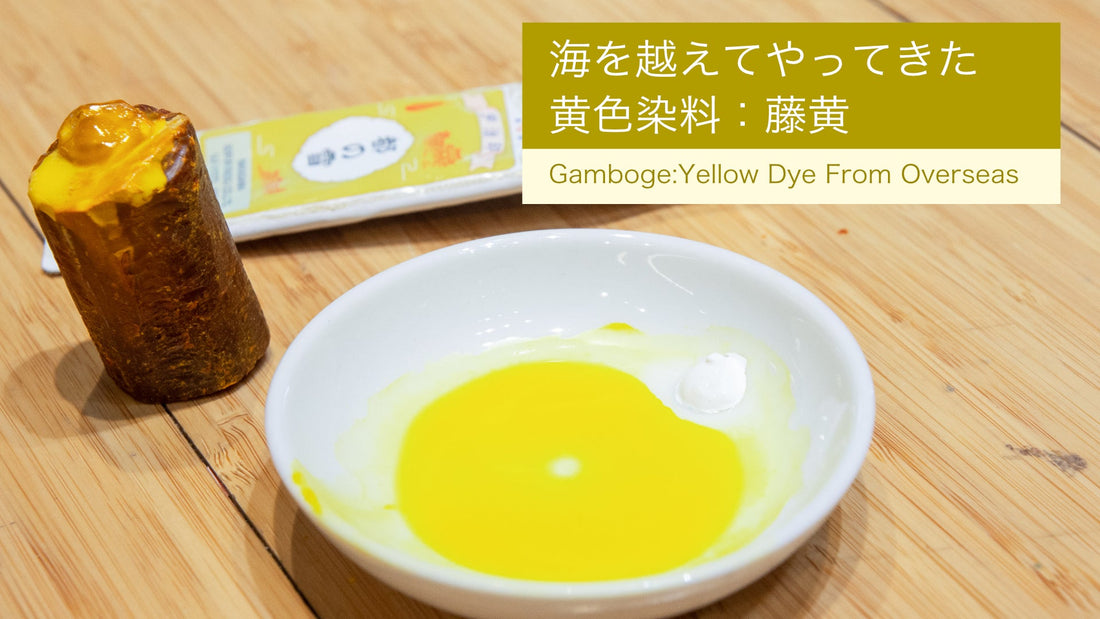Last Updated on October 22, 2025
Mineral pigments are not the only color material in Nihonga (Japanese painting), some colors are extracted from dyes. For example, the Gamboge, also known as Touou (藤黄) in Japanese, is one of those dyes.
Gamboge is made from the resin of the Garcinia trees of the family Clusiaceae (Guttiferae) and when dissolved in water, it produces a transparent saffron color.
Garcinia tree can be found in India, Myanmar and Thailand, and gamboge is made by coagulating a yellow rubbery latex extracted by slicing a groove into the bark of the tree.
In Japan, Gamboge has quite a long history and has been used for a pedestal of a gold-lacquered incense burner called “Urushi-Kinpaku-Enoban (Kouinza)” made in the 800s and has been kept in the Shosoin Repository in Nara. Gamboge was also used as an undercoating before applying metal leaf in Japanese art.
In Europe, it was widely used as a coloring agent for transparent watercolors, miniature paintings, gold burnishing and even for liquor coloring as early as the 1600s.
Compared to other yellow pigments that PIGMENT TOKYO carry, Gamboge has a little reddish shade and is slightly darker.

In some cases, this color material is commonly confused with orpiment, which is called Shiou (雌黄) in Japanese and also has a yellow color, although it is a mineral-based pigment and contains arsenic.
For example, the "Nihon Kokugo Daijiten (Shogakukan’s Japanese Dictionary) - Concise edition" states that the Chinese name for Touou (gamboge) is Shiou (orpiment).
However, Shiou is a yellow mineral pigment called orpiment in English and due to its toxicity, there are times when gamboge is substituted for orpiment today.
Gamboge is a water-soluble dye, while orpiment is a pigment which does not dissolve in water.
The difference between these two color materials is quite obvious if you see and touch them in person, however, they might be mistaken for each other because both of them are yellow and the orpiment is sometimes replaced by gamboge because of its extreme toxicity.
Moreover, in "Honzō Zufu (Diagrams and Chronicles of Botany)" published in the Taishō era (1912-1926), the gamboge is described as having a sour and slightly sweet taste in its fruit.
As for nowadays, if you search "Gamboge Fruit" on the internet, you can find some pictures of people actually trying to consume it, which indicates that it is still served as food in small quantities.
Knowing this does make us want to try some to see what it tastes like, right?
Next, I will show you how to use Gamboge yellow.
As you can see, it is pretty simple to use by simply soaking your finger with water and then moisturizing the tip of the Gamboge, after a while, you will see the color gradually oozes out.
You can now apply the color with your brush or you can use it directly on the paper.

It can also be pigmented and used as paint by mixing it with Gofun (white shell powder) containing animal glue.
In PIGMENT TOKYO, we carry Gofun in tubes which are already pre-kneaded with animal glue called Miyako-no-Yuki. By using it, you can easily turn the pigmented Gamboge into the paint.



【Art Materials Used】
Color Material: Gofun, Gamboge
Substrate: Bamboo Washi for Watercolor Art Pad
Other than that, you may also mix it with Suihi (tinted pigments) which are made of Gofun and other colorants. By doing this, you can create a different kind of color with Gamboge.
d coloring material, you can get a slightly different color.

【Art Materials Used】
Color Material: Gofun, Gamboge, Suihi Pigments
Substrate: Bamboo Washi for Watercolor Art Pad

【Art Materials Used】
Color Material: Gofun, Gamboge, Suihi Pigments
Substrate: Bamboo Washi for Watercolor Art Pad
Painting with yellow has been favored by artists throughout our long art history and no doubt it would keep on inspiring us evermore.
References
“Honzu Zufu (Diagrams and Chronicles of Botany)” by Tsunemasa Iwasaki, (Honzo Zufu Publishing, 1916-21)
“Color Guide Name Spelled in the Literature and Examples Color Swatch - New Edition of the Notebook Color” Supervised by Yasuhiro Nagata, (Shougakukan Inc., 2002)
“History of Art in Japan” by Nobuo Tsuji, (University of Tokyo Press, 2005)
"Japanese Traditinal Colors" by Yukio Yoshioka and Denshi Fukuda, (Art Books Shikosha Publishing, 2000)
“Nanpou Yuuyou Busshi no Kenkyuu” by Yoshihan Boeki Kabushiki Gaisha Research Department, 1942
“Encyclopedic Dictionary of Polymers” by Jan W.Gooch, (Springer Nature, 2007)
Scientific American 1855-04-28, Vol.10 Gamboge,Scientific American, a division of Nature America, Inc., 1855
Earth Titan, "Gamboge Taste Test | Unusual Foods" (viewed on June 15, 2022)


